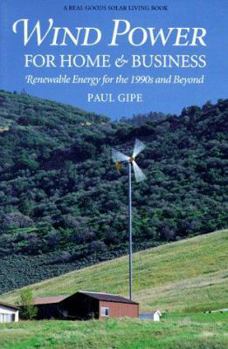Wind Power for Home & Business: Renewable Energy for the 1990s and Beyond
Select Format
Select Condition 
Book Overview
A comprehensive guide to using wind to power private houses and small businesses and farms. Describes and illustrates the wide range of systems now commercially available; suggests criteria for... This description may be from another edition of this product.
Format:Paperback
Language:English
ISBN:0930031644
ISBN13:9780930031640
Release Date:January 1993
Publisher:Chelsea Green Publishing Company
Length:413 Pages
Weight:1.55 lbs.
Dimensions:1.1" x 6.0" x 9.0"
Customer Reviews
3 ratings
Experience behind the theory
Published by Thriftbooks.com User , 15 years ago
Gives a great overview of the history of wind power, and a practical guide, backed up with decades of experience that any novice can understand. Great book for anyone who is new to small wind that wants to get involved or install their own system.
A Good Intro to a Much-Hyped Technology
Published by Thriftbooks.com User , 19 years ago
Many would like to take advantage of the wind, a so-called 'free' energy resource to do things ranging from pumping water for irrigation to supplying their home or business energy needs. Over the course of the book, via extended examples of practical, functioning and active wind power systems, Paul Gipe makes clear just how 'free' this free energy source actually is. While Mr. Gipe concedes readily that the wind can be harnessed to provide energy, he also patiently explains the limitations in doing so. Mr. Gipe is probably the technology's most level-headed advocate, and he makes clear what these systems can and can not do. Although wind energy systems have lots of potential, they often fall short for several practical reasons. As Mr. Gipe quickly points out, not all sites are suitable for harnessing the wind, and the most important criterion for wind energy development is the stability of the wind resource, and not necessarily its maximum speed (as it turns out, practically all commercially available systems will not produce any energy above a certain speed, for aerodynamic reasons). This is the first and most common misconception that Mr. Gipe dispels, and throughout the book he provides a lot of clarification on many other wind energy myths and misconceptions. A second very common misconception among the public, who have been sold these energy systems based on their clean image (zero greenhouse gas emissions), is the ongoing confusion between power and energy, which many consider to be equal. Gipe takes us slowly through the mathematics, and shows us the important difference between power and energy. Many unscrupulous advocates of so-called 'free' energy- solar and/or wind power have fooled more than a few technological neophytes by citing the high efficiency of such systems at converting the wind to power, er, ah, I mean energy. However, this is misleading for two reasons. First, power is not what we at home pay for; we pay for energy. Second, and most important, these knaves often cite efficiency at hub height, and not in terms of final output (which is what you really are paying for), when they 'sell' (more like hype) wind power. Granted there is lots of energy in the wind, but that is energy of motion, and that has to be ultimately converted into electrical energy to brew your coffee or run your toaster, and alas, the efficiency of such conversions is rather low, right around that for coal or petroleum fired electric power plants (and a bit below that of natural gas fired plants). The book covers all the wind power basics, from estimating your wind resource (distribution of wind speeds for your particular site), to estimating your annual energy output with a given system, to costing the system and issues related to siting and installation. All in all, it is a very comprehensive book, complete with chapters devoted to each aspect of an individual wind energy system- rotor, transmission, tower, as well as issues dealing with i
Wind Power ... Gipe has presented a well organized picture
Published by Thriftbooks.com User , 24 years ago
I have recently become interested in Wind Energy and the possibilities it presents for NY. With a finite supply coal/oil/ and other fossil fuels it is a matter of time before alternative forms of energy become cost effective. Gipe was able to present an overview of Wind Energy. He offers mathematical equations for the energy produced, The difference between Energy and Power, and practical presentation of how, what, and why Wind is a viable source. Chapters include: Measuring Wind, Estimating output, Economics of the system, Towers, Interconnections with a Utility, Stand Alone, Water pumping, Installation, and Safety.I would have liked to see more detail on placement added into the chapters but Gipe does give you other sources to look into. Overall Gipe does an excellent job of presenting Wind energy in an understandable fashion. I would recommend any interested in venturing into wind energy would start with reading this book. I am reading it for a second time.






